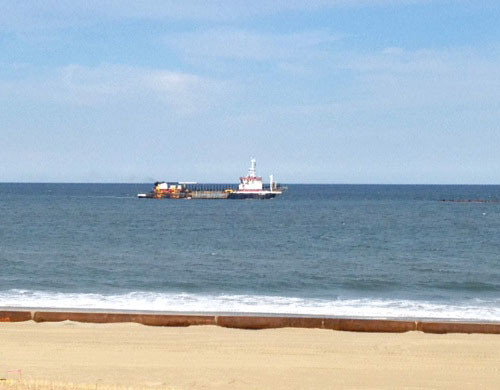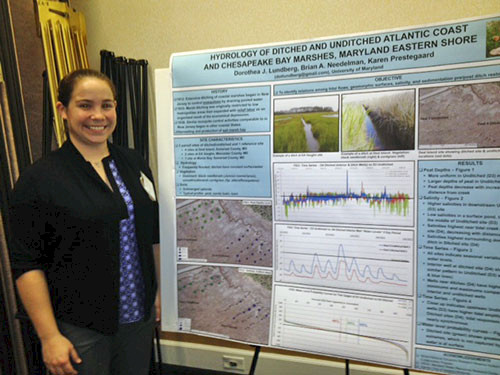Atlantic Estuarine Research Society conference in Ocean City, Maryland
Bill Dennison ·On March 28-29, 150 scientists gathered in Ocean City for a day and a half of talks, posters, eating and drinking, ice skating and swimming (indoors). The Atlantic Estuarine Research Society (AERS) is the original group of estuarine scientists, formed in 1949, which has been replicated first nationally and increasingly globally which has evolved into the Coastal and Estuarine Research Federation. Twice a year, AERS brings together students, scientists and educators from Delaware, Maryland, North Carolina, New Jersey, Pennsylvania & Virginia. It is a fun group, includes all career stages from advanced undergraduates (e.g., St. Mary's College of Maryland), graduate students, junior faculty, senior faculty and emeritus faculty.

I gave the opening keynote talk 'Eutrophication processes in Chincoeague Bay', which was focused on telling the story of identifying early stages of eutrophication, tracking down nutrient sources and observing an ecological phase shift in Chincoteague Bay. My conclusions were that ongoing monitoring and regular syntheses were crucial; targeted research that builds on previous results provides important advances; multi-disciplinary, multi-institution, multi-investigator efforts are needed to tackle emergent problems; and effective communication of the evolving understanding of Chincoteague Bay is important for research, monitoring, and management.
The coastal bays session that followed my plenary included talks by "Barium tracer" Chen, "Lagoonal cladoceran" Oghenekaro, "Amphibians & macroalgae" Morales-Nunez, "Benthic invertebrate" Mayor, "Sand shrimp" Chigbu, from the University of Maryland Eastern Shore (UMES), and "Terrapin headcounts" Mahoney from the Maryland Coastal Bays Program. The salt marsh session that followed had talks by "Geukensia biofiltration" Moody (who won the Best Graduate Student talk award), "Spartina catscans" Blum, "Phragmites & climate" Hager, "Marsh microbiology" Chintapenta, and "Terrapin telemetry" Ferguson.
The students organized lunch with the plenary speakers at a local restaurant which was very enjoyable. The afternoon keynote was by Denise Breitberg from the Smithsonian Environmental Research Center, who talked about how bulkhead and riprap shorelines leave small fishes between a rock and a hard place. The afternoon session included talks by "Fish & hypoxia" Dixon, "Croaker immunity" Wolfer, "Riprap fishes" Torre, "Charr metabolism" Stuffer, "Marsh hydrodynamics" Guiteras, "Hurricanes & horseshoes" Tedesco, "Stump cookies" award, "Terrapin rescue" Sellers and "Ocean planning" Hemphill.
The final plenary of the day was by Holly Greening from the Tampa Bay Estuary Program, describing the successful nutrient management story associated with Tampa Bay. Following the talk, this prompted us to develop the outline for a comparative review of Tampa Bay and Moreton Bay, Australia. Our tentative title is "The twenty seven degree solution", based on the common latitudes of Tampa Bay (27 degrees North) and Moreton Bay (27 degrees South). Both Bay ecosystems have a) about 2 million people in the watershed, b) upgraded the level of sewage treatment to gain water quality improvements, c) an active public engagement program, d) a suite of champions, and e) have a strong scientific basis for management.
The poster session was associated with happy hour and there was a wide diversity of poster topics. Dot Lundberg, a graduate student from the University of Maryland, College Park who was in the Science for Environmental Management course that Don Boesch and I teach, had a poster on her dissertation research on salt marsh ditching impacts. Dot's poster won the Best Graduate student poster award, and I hope that the science communication training that she received as part of the course had something to do with her winning the prize. The banquet dinner, featuring seafood and live music was very nice. The conference was in the Carousel Hotel right on the beach and has an ice skating rink in the open atrium, so many people brought their families with them. There was a large oceanic dredge moored directly offshore pumping sand onto the beach in the never ending effort to nourish Ocean City beaches in preparation for the summer.

The next morning session was kicked off with Anne Thessen's keynote talk on various aspects of scientific data, including data infrastructure, data providers, data consumers, data sharing, data hoarding and the data deluge. Anne posted her excellent PowerPoint slides on Slideshare website (Anne also is an alumna of the Science Communication course taught by IAN). Her talk was followed by talks by "Coastal Bobs" Levin, "Hematodinium methods" Sullivan, "Insitu sensor" Clark, "Louisiana diversions" de Mutsert, "Eigenvalve weighting" Fertig, "Trophic pathway" Wood, "SAV bicarbonate" Walker, "Crab parasites" Rugila, "Nouveau watermen" Bobpaul, "Larval swimming" Kennedy, and "Barnegat crab" Jivoff. The final keynote was Walter Boynton, who provided an entertaining, interesting and insightful talk about scientific synthesis, with a case study of Mattawoman Creek, Maryland. Walter made the point that he spent many decades studying environmental degradation and he wants to devote the remainder of his career studying restoration. Mattawoman Creek had the nutrient loads from sewage effectively removed and the response of the estuary was an initial resurgence of submerged aquatic vegetation (mostly Hydrilla and Myriophyllum to begin with), followed by improvements in chlorophyll (lower) and water clarity (higher). Walter called this case study "super good news" and provided the encouraging statement that a cleaner Chesapeake Bay is possible within our lifetimes.
There are several things I really enjoyed about this conference. The size of around one hundred and fifty people is a good size, the day and a half long program means that I didn't feel 'burned-out' at the end, the all-plenary sessions means that I am exposed to a broader diversity of topics than I would see at specialized break-out sessions. I learned about diamondback terrapins; telemetry was used to track their early morning swim followed by afternoon siestas, small terrapins get caught in storm drains in developments near marshes, and there is an active citizen science terrapin monitoring program. I learned about using hospital cat scans to measure salt marsh roots which can produce three dimension movies of roots, the "nouveau watermen" method of setting oyster larvae in temporary field mesocosms, and the potential importance of biofiltration by ribbed mussels in controlling picoplankton populations. And I also reaffirmed my continuing interest in the basic science of estuaries and coastal waters.
About the author
Bill Dennison

Dr. Bill Dennison is a Professor of Marine Science and Interim President at the University of Maryland Center for Environmental Science (UMCES).
Next Post > The Ohio River’s Split Personality
Comments
-
Atika 4 months ago
Thank you for sharing this great information with us, i really appreciate your post!